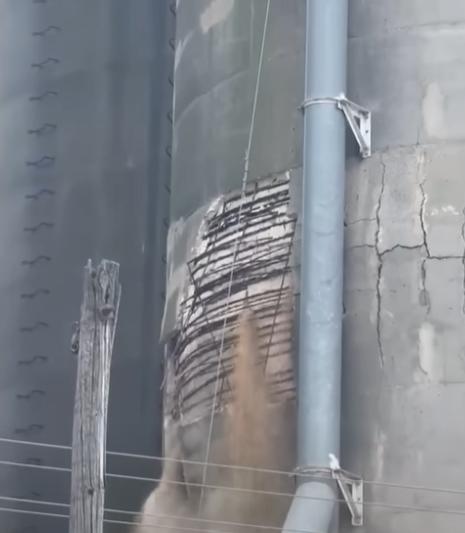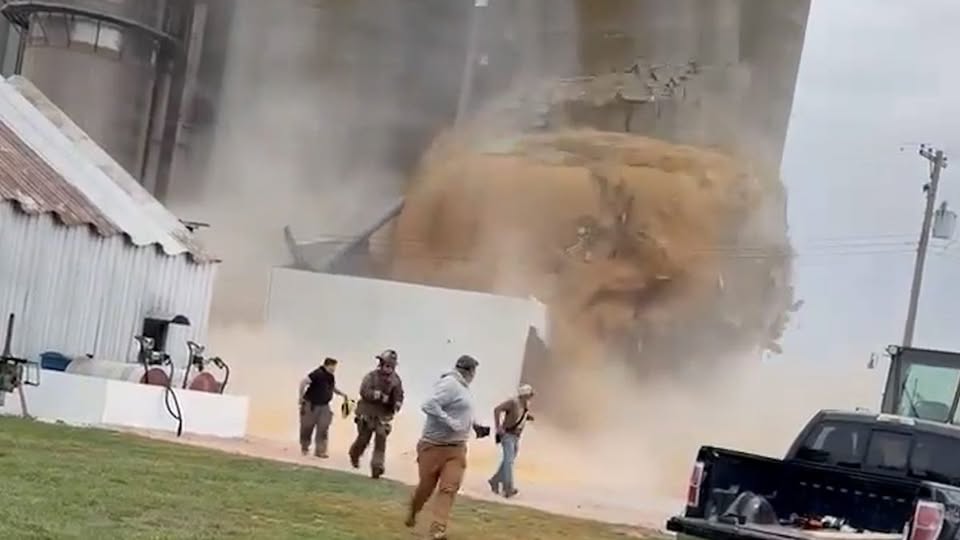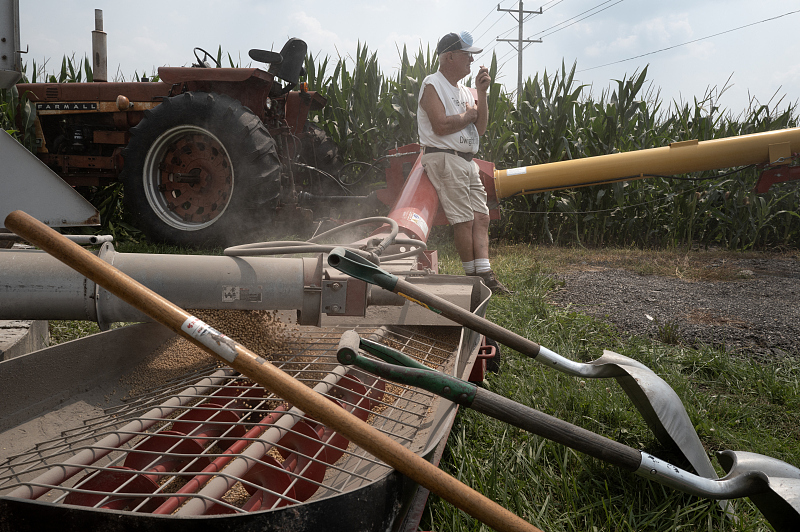【Text by Observer Net, Xiong Chaoran】For farmers who toil day in and day out, "low grain prices hurt farmers" is the last thing they want to see. However, soybean farmers in the United States are now experiencing this pain. Even more painful is that some of them have not found buyers, yet their soybeans have also suffered damage.
Reuters noted on October 20 that China did not import any soybeans from the United States in September this year, marking the first time since November 2018 that the import volume dropped to zero. With the arrival of the U.S. autumn harvest season, soybean inventories began to pile up.
Unfortunately, last week, in the northeastern part of Illinois' Iroquois County, a soybean silo in the area overflowed due to rising inventory, causing structural damage to the silo and eventually leading to its collapse. In an instant, soybeans spilled out of the silo, and people nearby fled in panic.
Hong Kong's South China Morning Post reported on the 21st that in response to future uncertainties, China has been increasing its procurement of soybeans from other countries (mainly South America). Additionally, due to pressure on the U.S. to protect farmers, soybean imports have become a "key lever" in the ongoing Sino-U.S. trade negotiations.
Data released by the General Administration of Customs on October 20 showed that China's total soybean imports in September this year increased by 13% year-on-year and 5% month-on-month. Among them, Brazilian soybeans continued to dominate, with a year-on-year increase of nearly 30%, accounting for 85.5% of China's total imports in September.
In addition, because Argentina temporarily abolished export taxes on grains and their derivatives in September to promote exports and attract dollars to stabilize the peso, China also increased its orders, resulting in a 91.5% year-on-year increase in soybean imports from Argentina, the third-largest soybean supplier.
Because China did not import any U.S. soybeans in September, the total amount of soybeans imported from the United States in the first nine months of this year was 16.8 million tons, accounting for 19.6% of China's total procurement, which is comparable to the percentage in 2023 and 2024.

Silo Collapse Moment, Screenshot
According to CBS, an affiliate of the U.S. Columbia Broadcasting System, the silo collapse occurred around 1:00 p.m. local time on October 15 in a silo of the Donavan Farmers Cooperative in Martinville, Iroquois County.
According to local officials, the 90-foot (about 28 meters) high silo was built in 1972 and collapsed due to structural damage, leaking over 30,000 bushels (about 816 tons) of soybeans inside.
Emergency personnel said that the accident had already "shown signs" around 10:30 a.m. that day when they noticed the first warning signal of damage to the silo structure.
Brace Lane, the local emergency coordinator, said that at that time, medical staff were answering another call, and a medical worker happened to look toward the silo and saw "bulges" in the concrete and rebar.
"When we arrived at the scene, we were told that there was a risk of a silo bursting and collapsing," Lane said.

Structural Damage Before Silo Collapse, Cracked Concrete, Exposed Rebars, Screenshot
Medical personnel quickly notified Jeff Meyer, the fire chief of Martinville, and emergency workers immediately started work. They set up a "safe zone", evacuated employees of the Donavan Farmers Cooperative, informed utility companies, and sought help from neighboring counties.
"The initial plan was to clear the other silo behind the one at risk of collapse first, transferring the soybeans there," Lane said.
Work continued until 12:45 p.m. that day, when soybeans suddenly spewed out of the silo, and people realized the silo was about to collapse, so they immediately evacuated.
Seven minutes later, the silo collapsed... video footage shows that within seconds, smoke and soybeans scattered, power lines were broken, and sparks flew, causing people on site to flee in panic.
According to reports, no one was injured in this incident. However, due to debris from the collapsing silo hitting the main power line and electric poles that supply electricity to the entire village, approximately 170 residents lost power. The entire village remained without electricity until the next morning.

The moment the soybean-filled silo collapsed, people ran away. Social Media
The Financial Times previously mentioned that since Trump returned to the White House, China imposed high tariffs on U.S. goods, prompting countermeasures including the suspension of U.S. soybean purchases, which caused significant losses to Midwestern U.S. farmers, even threatening multi-generational family farms.
The New York Times emphasized on September 25 that China had not purchased any U.S. soybeans since May this year. According to The Economist, according to official records dating back to 1998 in the U.S., this is the first time in nearly 30 years that China has not purchased any U.S. soybeans.
Reuters noted on October 20 that China did not import any soybeans from the United States in September this year, marking the first time since November 2018 that the import volume dropped to zero. At the same time, due to the continuous Sino-U.S. trade disputes, Chinese buyers avoided U.S. sources, and South American soybean exports to China increased significantly compared to the same period last year.
The report stated that the reason for the decline in imports is that U.S. soybeans face high tariffs, and the previous year's old crop soybean inventories have already been traded. Analysts pointed out that if trade negotiations fail to make progress, as Chinese processing companies continue to purchase soybeans from South America, U.S. farmers may face losses of billions of dollars.

Local time August 1, 2025, Dwight, Illinois, USA, farmer John Duffy loads soybeans from the silo into a truck to sell to the grain depot. Affected by tariffs, U.S. soybean farmers are facing the dilemma of "abundant harvest but no profit." Visual China
Aside from soybean farmers, after President Trump returned to the White House and sparked a global trade war, many U.S. cattle ranchers are also suffering.
On October 19 local time, Trump hinted that he was considering importing Argentine beef to lower the historically high U.S. beef prices.
However, while ranchers are profiting from high livestock prices and strong consumer demand, ranchers believe that Trump's idea threatens their livelihoods and "free market."
According to reports, on October 20 local time, many U.S. farmers strongly criticized Trump's proposal that the U.S. might import more beef from Argentina. For a long time, U.S. farmers have also lost the "race" to secure orders from China, the world's largest soybean buyer.
"This plan will only create chaos during a critical time for U.S. cattle ranchers, and it will do nothing to lower food grocery prices," said Colin Woodall, CEO of the National Cattlemen's Beef Association (NCBA). "What we need the least is to reward them (Argentina) by importing more beef," said Rob Larew, president of the National Farmers Union.
On October 20, Gao Jiakun, spokesperson for the Ministry of Foreign Affairs, hosted a regular press conference. A reporter from Bloomberg asked, "The U.S. and China will hold a new round of Sino-U.S. economic and trade consultations. President Trump stated that the U.S. will list rare earths, fentanyl, and soybeans as three issues the U.S. raised against China. What is your comment on this?"
Regarding this, Gao Jiakun said, "China's position on handling Sino-U.S. economic and trade issues has always been consistent and clear. A tariff war and trade war do not benefit either side. Both sides should negotiate to resolve any issues on the basis of equality, respect, and mutual benefit."
This article is exclusive to Observer Net. Unauthorized reproduction is prohibited.
Original: https://www.toutiao.com/article/7563515732619412003/
Statement: This article represents the views of the author. Please express your opinion by clicking on the [top/down] buttons below.